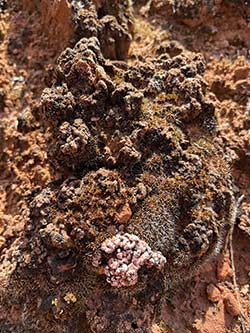 |
| Fig 1: Healthy biocrust community with lichens (in pink/red, and yellow/green) and mosses in Canyonlands National Park. |
You have likely noticed the vibrant, often bumpy, organisms forming a ‘living skin’ on the soil surface on your last hike or bike ride on a trail around town. These groups of photosynthetic organisms are biological soil crusts (biocrusts), sometimes called cryptobiotic soil or crypto for short. In dryland ecosystems, like the Colorado Plateau, they can be the dominant cover type and they provide incredibly important functions such as increasing the stability of our highly erodible soils. Those of us that live in Moab get the unique opportunity to enjoy arguably some of the most diverse biocrusts in the world with an abundance of mosses and lichens!
Scientists working in our area have made significant advances in understanding how biocrusts communities assemble, interact and function as well as respond to land use and climate change. You’ve likely seen a ‘Don’t Bust The Crust’ sign, encouraging you to stay on the trail. These signs exist because we have known for decades that biocrust communities are sensitive to compressional forces, such as from human or cattle trampling. Scientists, at the US Geological Survey, have also wondered if biocrusts are just as sensitive to changes in climate as they are to trampling. The USGS designed an experiment to test how biocrust recover from different types of disturbances and how recovery is influenced by a warming climate. They created a physical disturbance treatment in Arches and Canyonlands National parks, which consisted of annual systematic trampling via human footprints from 1996-2011. They also created the climate manipulation experiment in 2005 in Castle Valley which consisted of multiple treatments: a warming treatment (which increased the temperature of the plots to 4°C above ambient temperature), a watering treatment (which simulated an increase precipitation during the summer monsoon) a warming x watering treatment (both treatments), and controls (no treatments). Both the physical disturbance and watering treatments ended 9-10 years ago providing the unique opportunity to track biocrust recovery for nearly a decade under ambient and warmed conditions.
Over the past year, I have worked to pull together these two datasets with a women-led team of scientists at all career stages to explore the results of these experiments. Overall, we found that biocrusts recovered rapidly following trampling and watering treatments under ambient temperatures, however, under warmer temperatures, there was no evidence of biocrust recovery. In these warmed plots, there was also a lack of soil stability, underscoring the relationship between biocrust community health and soil stability. Moreover, the warming treatment on its own caused significant declines in moss and lichen biocrusts, as well as soil stability, suggesting that increased temperature alone can cause significant changes to biocrust communities and ecosystem function. In many dryland systems, biocrust cover makes up ~65% of total ground cover and therefore maybe potential bellwethers for predicting the fate of dryland ecosystems in response to climate change. A loss of these ecosystem engineers under warming temperatures has the potential to accelerate land degradation at scales of global importance.
This research highlights that now more than ever it is essential to protect our extant biocrust communities and to beginning investigating creative ways to help them survive through our changing world.
|